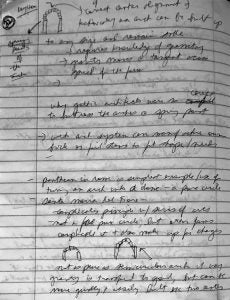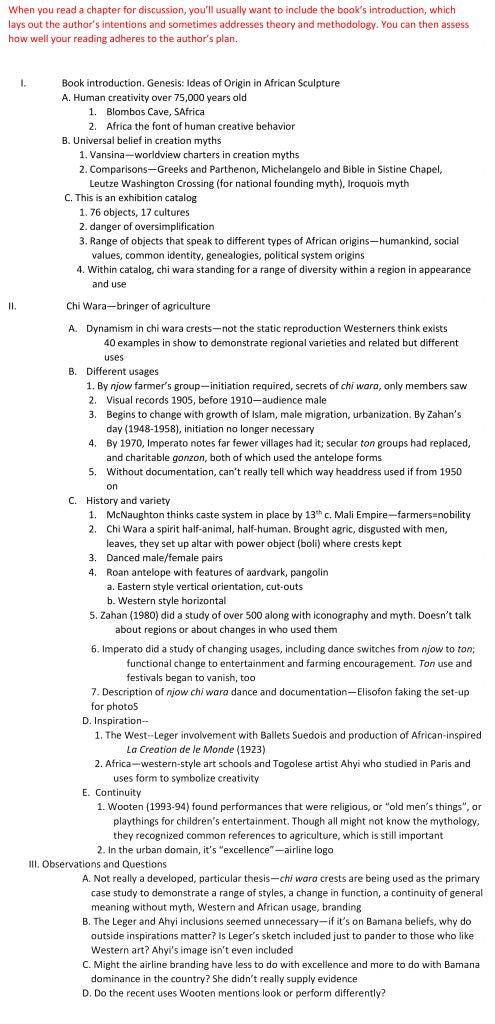Appendix A: Taking Notes
Class Notes
Note-taking from lectures is essential. Students often overestimate their ability to remember things without writing them down. Unfortunately, information that seems obvious one day may become a mystery a month later, when testing is about to occur.
Notes, of course, are not meant to be an exact transcription–outside of a court, that is unnecessary. In African art history, most important points a lecturer makes are fairly easy to spot, as long as you’re listening. Some basic information–definitions, technique, gender of artists–needs to be recorded from speech alone. Most information, however, is linked to projected images. The best way to be sure you’re linking information to the correct image is to make a schematic drawing. We won’t go so far as to call it a sketch–you’re trying to capture the information, not record a perfect image (Fig. a). Why bother to make a quick drawing? The reasons are two-fold: you’ll be able to match information to specific testable images and just by marking basics, you’re noticing things about style–is the head one-third of the body height? Does the figure slant forward? Do the legs flex into two strong diagonals?


Approaches to taking art history notes vary. Some (Fig. a) are free-form in nature and don’t even conform to the lines on the page, while others are more orderly, emphasizing verbal over visual notes (Fig. b). Both are the work of former students who averaged A+ in all their art history courses, so it is clear there is not only one way to succeed. The video below shows a more structured method that might appeal to a different kind of student.
Be aware that numerous studies have found that writing your classroom notes rather than typing them promotes retention. Taking notes by hand also requires you to edit on the fly, selecting important concepts to record. This by-hand method also gives you the flexibility to not only add sketches, but underline concepts that might be repeated several times or otherwise stressed by the lecturer.
Examples
Try the following links for additional note-taking examples for art history (not necessarily for African art, but the same principles
- A lecture about a single painting by a known artist
- Summarizing an artist’s style (could apply to the general traits of an ethnic group’s style)
- Summarizing the style and subject matter of a particular place and period–an artist’s (Chandler O’Leary) college lecture notes on female nudity in Renaissance and Baroque art
- Good general tips for art history note-taking
Be aware that some of the information heard and recorded in class applies to more than one artwork. If your professor shows you a series of Yoruba twin figures, for example, information on meaning and function applies to all of them, not just the object that happens to be on the screen at the moment. Why are you shown multiple examples of the same type of figures? Multiple images illustrate either how much variation the same object type may have within a region, or how consistent the object’s appearance may be. In short, the variations (or lack thereof) show a stylistic range, even when meaning and function are unchanged.
Notes on Informative Readings
While highlighting is a time-honored way of taking notes as you read a textbook or a required article, it is the path of least resistance and often has little to offer. When you gaze at a photocopy or textbook and see lines of yellow or blue, you feel as if you’ve accomplished something. Often, however, nearly a whole page is highlighted. It is more useful to read a paragraph and consider the critical ideas and/or information it conveys. In your class notebook, consider what those essentials may be. The definitions of new terminology and techniques are critical, as is information about the context an artwork draws from–its religious or social usage, symbolism, any significance regarding the materials used, whether the style conforms to other works by the artist or ethnic group, or whether it is atypical or standard for its time and place. Take written notes–summaries in abbreviated form, just as you do during a lecture.
Because you can see the scope of the topic, however, you the advantage of choosing from several different note-taking methods. If your readings reinforce what you’ve covered in class, you can return to your class notes and add details and clarifications (or points of disagreement) to the notes you’ve already taken–an additive method. You can decide to create a formal outline, a time-tested way of summarizing that enables you to not only collect critical information but to discern the author’s structure of organizing the material. You might choose to create a mind map, a method that identifies core concepts and key details without a rigid structure.
Examples
Let’s look at a passage about Bamana chi wara crests from Alisa LaGamma’s Genesis: Ideas of Origin in African Sculpture (New York: Metropolitan Museum of Art, 2002). Click HERE to see it. The extract is on pages 12-24. Read through it, consider what kinds of notes you usually take, and consider the advantages and disadvantages of the following examples of note-taking.
The advantage of additive notes (Fig. c) is that this method forces you to consider whether the reading is offering you new information or not (so you are reviewing your class notes at the same time) and to decide where the appropriate point for insertion in your class notes might be (also requiring a quick review). In addition, all of your notes on the topic are together when it comes time to study.

Outlining an article allows you to see its structure more clearly. This is effective for preparation for discussion, but not necessarily useful for study. It requires you to repeat information you already have in your class notes. Mind-mapping allows you to associate ideas, but again repeats the material you took notes on in class.

Notes on Discussion Readings
Smaller classes often include readings whose purpose is class discussion. Such conversations do not usually center on the information the texts convey, but rather emphasize the author’s viewpoint, thesis statement, argument and evidence, structure, theory, and unconsidered questions. This requires a different method of reading and note-taking, and is independent of class notes, as its intent is separate. If the same chapter section were assigned for discussion, how would it be addressed through notes? Additive notes would be useless; either the outlining or mind map methods would be more helpful. With either approach, a section should be added that includes the reader’s thoughts on the article and what might be points of discussion (Fig. d).
This is where you can add appendices or other back matter.

